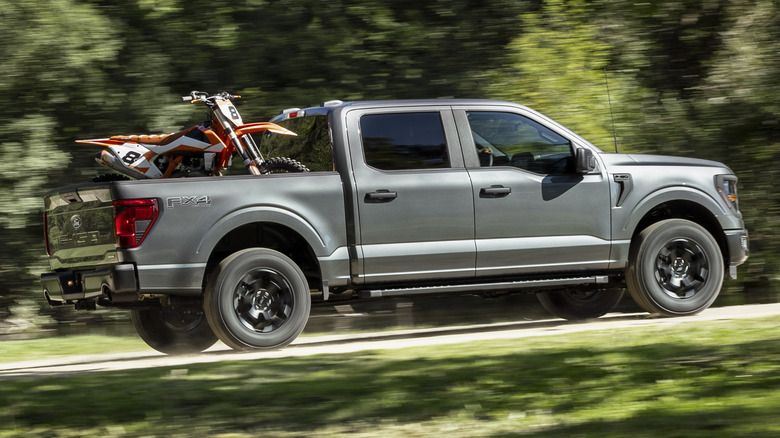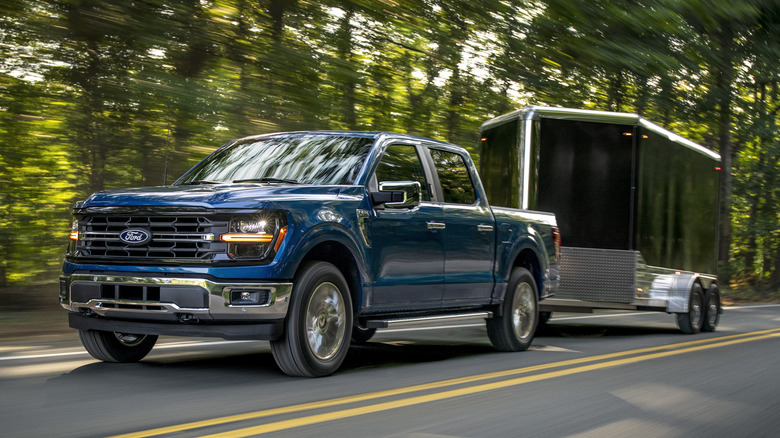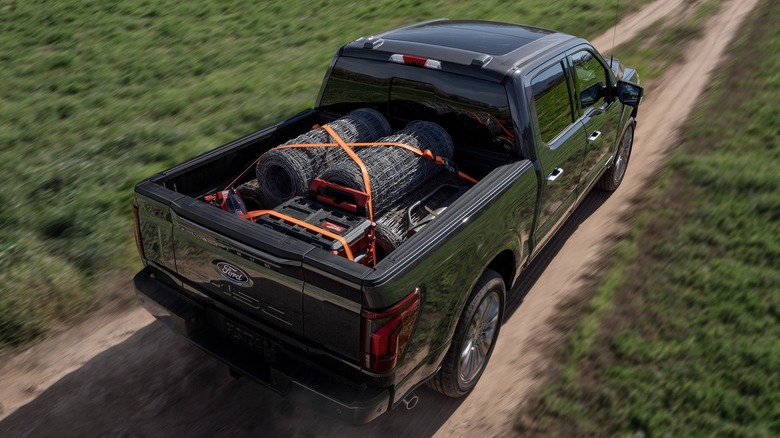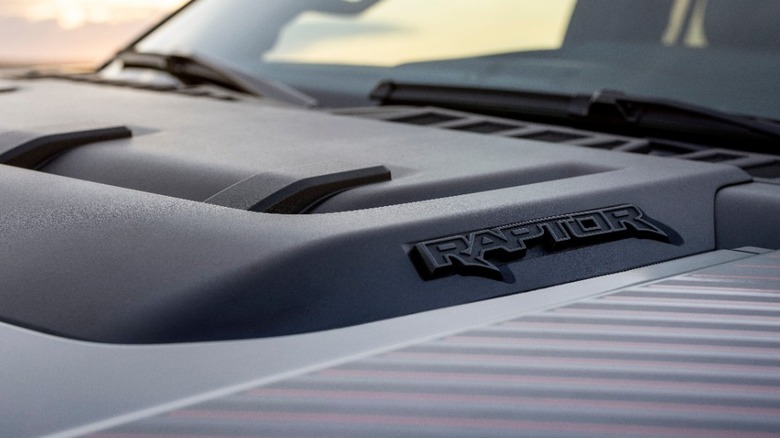What Engines Are Available For The 2025 Ford F-150 & How Do They All Compare?
The Ford F-150 is one of the top trucks in the game. It competes against other full-size pickups like the Ram 1500, the Chevy Silverado 1500, and, to a lesser degree, the Nissan Titan and Toyota Tundra. It has impressive towing and hauling capacity, a refined and modern interior, and all sorts of nifty truck tricks up its sleeves. The F-150 features impressive equipment, like the Pro Access Tailgate, hands-free driving from Ford's BlueCruise system, and an available hybrid model that can provide power for your home or job site via their Pro Power Onboard system.
In 2024, the F-150 was thoroughly updated with more power and a fresh design, but what powers the F-150 now? Does it still offer the same robust set of standard and available engines? In short, yes. In 2025, the F-150's engine choices have carried over, so there's still a lot to choose from — six engines in total. Each engine has its strengths, so let's see how they stack up against each other.
2.7-liter EcoBoost V6
Ford's 2.7-liter EcoBoost V6 is the standard powertrain and the least powerful engine in the F-150 lineup, but it's no slouch. The 2.7-liter engine uses twin turbochargers and produces 325 horsepower and 400 lb-ft of torque. Depending on the configuration of the F-150 you choose, the 2.7-liter engine is capable of towing as much as 8,400 pounds, with a maximum payload of 1,785 pounds. As with all the engines in the F-150 lineup, the 2.7-liter engine is paired with a 10-speed automatic transmission.
With rear-wheel drive, the 2.7-liter engine is rated by the EPA to return 19 mpg city and 25 mpg highway. Go with four-wheel drive, and those ratings drop slightly to 18 mpg city and 23 mpg highway. It's not the most efficient version of the F-150, but for a full-size pickup truck, those numbers are certainly respectable. For comparison, Ford's midsize truck, the Ranger, tops out at 21 mpg city and 25 mpg highway.
5.0-liter V8
The F-150's V V8 offers quite a bit of capability, and it offers the interesting distinction of being the only naturally-aspirated engine in the F-150 lineup. The 5.0-liter V8 produces 400 horsepower and 410 lb-ft of torque, a stout set of numbers by any pickup truck standard. Compared with the standard 2.7-liter engine, the V8 is significantly more capable in the towing and hauling departments. It has a maximum towing capacity of 12,900 pounds –- more than the Nissan Titan or the Toyota Tundra –- and a max payload of 2,225 pounds.
The V8 is available with a number of different F-150 configurations. In rear-wheel drive and four-wheel drive configurations it is estimated to return 16 mpg city and 19 mpg combined. With the off-road Tremor package, however, those estimates drop a bit to 15 mpg city and 17 mpg combined. Some of that decrease can be credited to the Tremor's increased weight and off-road-oriented tires.
3.5-liter EcoBoost V6
The 3.5-liter EcoBoost V6 is the towing and payload champ amongst F-150 engines. Maximum towing checks in at a very impressive 13,500 pounds, and payload maxes out at 2,440 pounds. When it comes to towing, that's the maximum number for the F-150, and it's a class-leading number amongst trucks like the Silverado 1500 (which maxes out at 13,000 lbs) and the Ram 1500 (with a max of 12,750 lbs). The 3.5-liter EcoBoost puts out pretty big power numbers in order to achieve its hefty tow ratings –- 400 horsepower and 500 lb-ft of torque.
The 3.5-liter engine isn't as efficient as the smaller 2.7-liter V6, but that's to be expected. According to the EPA, it checks in at 17 mpg city and 25 mpg highway with rear-wheel drive models. With four-wheel drive, those estimates drop to 16 mpg city and 24 mpg highway. Go with the Tremor trim level, and highway fuel economy takes a 3-mpg drop from there.
3.5-liter PowerBoost full-hybrid V6
The fuel-economy king in the F-150 lineup is the PowerBoost full-hybrid V6. The turbocharged 3.5-liter V6 is paired with a hybrid-electric system that pumps fuel economy up to an EPA-estimated 22 mpg city and 24 mpg highway. Those are the best numbers the F-150 offers, and they're very competitive in the class. The PowerBoost also produces 430 horsepower and 570 lb-ft of torque -– significant increases over the 3.5-liter engine on its own. The PowerBoost engine has an impressive maximum towing capability of 11,200 pounds, but its payload is a bit lower than some other F-150s –- it maxes out at 1,740 pounds.
Another big benefit that's derived from going with the PowerBoost is the 7.2kW Pro Power Onboard system. With multiple plugs in the F-150's bed, you can supply power to tools on the job site or recreational devices at the campsite. Whether you're sawing lumber or pumping up an air mattress to sleep under the stars, the PowerBoost engine has you covered.
3.5-liter high-output EcoBoost V6
The PowerBoost is a more efficient version of the 3.5-liter V6, but the high-output EcoBoost goes another direction. Available exclusively under the hood of the F-150 Raptor, this engine provides pumped-up performance via increased horsepower and torque. It puts out 450 horsepower and 510 lb-ft of torque, and it comes with all sorts of off-roading equipment that will get you as far from civilization as you want to go. Be sure to fill up your tank before you go adventuring, though, as the Raptor's fuel-economy ratings are expectedly low. With only one four-wheel-drive configuration, the Raptor's EPA estimates check-in at 14 mpg city and 18 mpg combined.
Unfortunately, the Raptor also takes a bit of a hit when it comes to towing and payload. With the standard high-output V6, the Raptor tops out at 8,200 pounds of towing capacity and 1,400 pounds of payload. Off-road-focused suspension generally struggles with this trade-off, losing a bit of towing and payload capacity to accommodate things like suspension travel and increased ride height. The Raptor is no exception to this rule.
5.2-liter supercharged V8
The Raptor R is the top of the heap when it comes to F-150s. It is the most extreme, most off-road capable truck in the F-150 lineup, and it goes toe-to-toe with some of the baddest full-size pickups out there. The Ram TRX no longer exists, but it was the Raptor's strongest competition for quite some time. The Ram produced an incredible 702 horsepower and 650 lb-ft of torque with its Hellcat-sourced supercharged 6.2-liter V8, but the Raptor R's engine beats it, at least in the horsepower department. Ford's supercharged 5.2-liter V8 produces 720 horsepower and 640 lb-ft of torque. The Chevrolet Silverado ZR2 offers quite a bit of its own off-road capability but nowhere near the power of the TRX or the Raptor R.
The Raptor R, like the standard Raptor, has limited payload and towing capability. It tops out at 8,700 pounds of maximum towing and 1,400 pounds of maximum payload –- both numbers should be enough to tow or haul a few toys out to your local OHV area and enjoy a weekend adventure, but towing and hauling really isn't this truck's primary purpose. And if fuel economy is even remotely a concern of yours, steering clear of the Raptor R is probably your best bet. The EPA estimates it'll return an abysmal 10 mpg city and 15 mpg highway.






